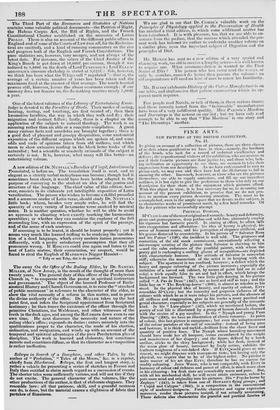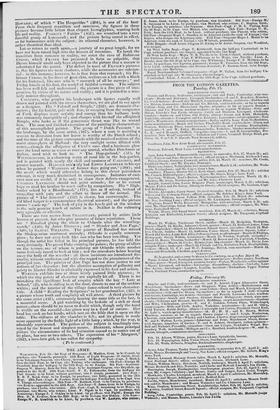FINE ARTS.
NEW PICTURES AT TIIE BRITISH INSTITUTION.
No. H.
IN giving an account of a collection of pictures, there are three clasm of reAders whose gratification we have in view,—namely, the brethren of the brush, who look for a record of technical excellencies and defects ; the unprofessional visiters of the exhibition, who are anxious to see if their favorite pictures are done justice to ; and those who, lack- ing inclination or opportunity to see them, are content to take their impressions from our description. As we have endeavoured in turn to please each, we may now and then have had the ill-fortune to fail in amusing the other. Inasmuch, however, as those who see the pictures themselves, are able to supply omissions, and fill up our imperfect outlines, it is but right to give the preference to those who rely on our description for their share of the enjoyment which pictures afford. With this object in view, it is less necessary for us, in resuming our account of the present exhibition, to premise that we do not pro- fess to mention every picture deserving attention. The most to be accomplished, even in the ample space that we devote to the subject, is to characterize works of prominent merit, by a few brief remarks. Of the few painters who successfully attempt
POETICAL DESIGNS,
M'CLISF. is one of the most original and versatile : beauty and deformity, grace and grotesqueness, deep pathos and wild fun, alternately employ his vigorous but fantastic pencil. In aiming at effect, be often falls into exaggeration and affectation : his idea of beauty is physical, his sense of humour coarse, and his perception of elegance artificial, and his genius distorted by eccentricity. In his picture of " Salvator Rosa and his Patron" (138), the incident is well told. The grimaces and contortion of the old mock connoisseur, ostentatiously affecting. a microscopic scrutiny of the picture that Salvator is showing to him —and the calm endurance of the youthful painter, with whom the pretty girl is exchanging a smiling glance of recognition—are depicted. with characteristic humour. The attitude of Salvator is somewhat stiff; otherwise the mannerism of the artist is in keeping with the subject. The apartment is too confined, however; a defect which the heavy and opaque colouring of the picture increases; especially the imitation of a carved oak cabinet, by means of paint laid on in solid relief, a trick equally false in art and bad in effect, which brings the background too forward. The two little girls dancing in his picture called "A Pas de Deux" (447), are as hard and stiff as toys ; and the little boy on " The Rocking-horse" (389), is almost as wooden as his steed. In the physical idea of beauty, and opacity of colour, ETTY resembles APCuse ; but the intensity and gorgeous richness of the colours with which he as it were inlays his pictures, and the absence of all stiffness and exaggeration, give to his works a more poetical and genial character; especially as his subjects are generally of the romantic kind. In his " Lute-player" (52), which we mentioned before, the poetry of real life is illustrated by a group of buxom damsels charmed with the strains of a gay cavalier. In the " Nymph and young Faun Dancing" (200), we have an illustration of classic romance. In point of colour, this last picture is sumptuous ; but even the voluptuousness of the colour partakes of the soil of sensuality : instead of being pure and lustrous, it is thick and turbid—brilliant from the sheer force and quantity of positive hues. The Nymph whose bounding movement should have made her all buoyant, seems encumbered by the weight and massiveness of her drapery ; and the figure, defined by a harsh outline, sticks to the skiey background; while her flesh, instead of the warm glow of beauty, increased by lively action, exhibits the leathern toughness of a sun-baked skin If Errv:would gives us sen- timent, we might dispense with transparent tints; but having only the physical, we require that to be of the highest order. No painter is more master of his art than ETTY, therefore he has no excuse for muddy colouring. Joins WOOD, who is not comparable, with ETTY in harmony of colour and richness and power of effect, is much more clean in his colouring : his flesh tints are remarkably warm and pure. But, with all his mechanical skill, he will never attain eminence, unless he puts more mind and originality into his pictures. His " Psyche borne by Zephyrs" (445), is taken from one of HOWARD'S flying groups ; and " Cupid and Calypso" (344), is a composition in the conventional style of academic designers. Feeble character and vague expression moreover, render these pictures iiiiipid, if not actually unmeaning. These defects also characterize the graceful and poetical fancies of
Hemmen; of which " The Hesperides* (204), is one of the best. From their frequent repetition and sameness, the figures in these pictures become little better than elegant hieroglyphics, wanting both life and reality. Pannis's " Fairies " (451), are wreathed into a very fanciful group of homunculi,- and the picture being unreal in effect, so far harmonizes with the subject : its ethereal character, however, is rather theatrical than ideal.
Let us return to earth again,-a journey of no great length, for we have not been raised high into the heaven of invention. To break the transition from romance to reality, we enter the cave of Robinson Crusoe, which Fassea has presented in form so palpable, that DEFOE himself could only have objected to the picture that a macaw is substituted for the parrot. The defect in most of Fassia's pictures is, that his figures are mere shadows, while the accessories are substan- tial : in this instance, however, he is free from that reproach - his Ro- binson Crusoe, in his dress of gout-skin, reclines on a tub wall a block for his footstool, like one who is " monarch of all he surveys ; " and Friday kneels at his feet, the model of faithful servants. The subject has been well felt and understood : the picture is a fine piece of ima- gination, by virtue of its nature and reality; and it is plantain a mas- terly manner throughout.
CALLCOTT, who peoples his landscapes with figures equally well drawn and painted with the scenes themselves, we are glad to see again as a designer. His " Falstaff and Simple," (25‘2), are dramatic cha- racters • the fat knight, pale with fear, in escaping from the vengeance of Fun), displays more activity and energy than his bulbous body was commonly susceptible of ; and charges with his staff the affrighted Simple, who looks as if the gamesome thrust was like to wound him. The neat and finished execution of the painting is characteristic of this accomplished painter. The group of " Dutch Peasants " in the landscape, by the same artist, (167), where a man is assisting a woman to dismount from her horse is worthy of the Dutch school ; and the tone of the picture corresponds with the received notions of the moist atmosphere of Holland : the very sunlight seems diluted with water,-though flee effulgence of CUNT'S suns shed a luminous glow over the level scene as warm as ever any mortal, whether Dutchman or Italian, need wish to bask in. " The Hop-garland," (51), by WITHERINGTON, is a charming scene of rural life in the hop-garden, and is painted with nearly the skill and neatness of Cm-Leo-re, and greater warmth. I-Les:coos eviisritly had EDWIN LANDSEER in his eye when he painted " Warreners of former days going out," (504); and the merit which would otherwise belong to this clever painstaken attempt, is very much diminished in consequence. Imitators of emi- nent men are useful, if it be only to show their defects exaggerated. CHAELEs LANDSEER should not paint animals ; for as he cannot hope to rival his brother be must suffer by comparison. His " High- lender seized by a Bloodhound," (170, lies as if asleep, instead of struggling with rain and the effort to throw off the animal. His picture of " The Aiinstrel" (452) is clever, but overwrought. The old blind harper is a commonplace theatrical minstrel ; and the picture seems " made up." The look of pity in the lovely girl at the window is the only genuine touch of nature in it. Neither is the colouring very agreeable or effective. There are two scenes from Slim:sin:ant, painted by artists little known at present, but who give • promise of future reputation. These are " Rosalind giving the chain to Orlando after the wrestling- match," (150), by JOHN /31tiDGE5 ; and " Slender and Ann Page," (328), 1;y SAMUEL WILLIAN1S. The painter of Rosalind has missed the Shakspvarian sentiment entirely; Orlando is equally common- place ; he does not even look like one who has been wrestling. Yet though the artist has failed in his principal persons, Le has told the story distinctly. The proud Duke entering the palace; the group of idlers on the terrace, one of whom is pointing out Orlando while another turns listlessly round to look at him ; and the attendants below bearing away the body of the wrestler : all these incidents are introduced dis- tinctly, without confusion, and with due regard to the prominence of the principal one. The painter of Ann Page has not done justice to our notions of her character : but the abortive assumption of gallantry and gaiety in Master Slender is admirably expressed in his face and action.
Weesrsa exhibits two or three nicely painted little pictures ; in which the tiny points of character are capitally hit off. There is no mistaking the significant look of enquiry which the boy " Late at School," (2), who is sidling in at the door, directs to one of the urchins
within ; and the interior of the village dame-school is very character- istic. A child " Reading the Scriptures" to her grandmother, (22), is a picture whose truth and simplicity all will attest. A third picture by the same artist (431), erroneously bearing the same title as the last, is a mournful scene. A girl watching by the bedside of a sick or dead parent-there should be no room to doubt which, though only the hand is visible on the coverlid-has given way to a flood of sorrow. Her head has sunk on her hands, which rest on the bible that is open on the table. The stillness of the chamber is felt ; and its gloom is made more apparent by the feeble light of a little lamp ; which, by the way, is admirably represented. The pathos of the subject is touchingly con- veyed by the fewest and simplest means. HERBERT, whose principal picture the circumstance of its bad situation caused us to notice out of its place' has one or two others. The expression of his" Margaret," (262), alove-lorn girl, is too sullen for sympathy.
(To be continued.)

























 Previous page
Previous page